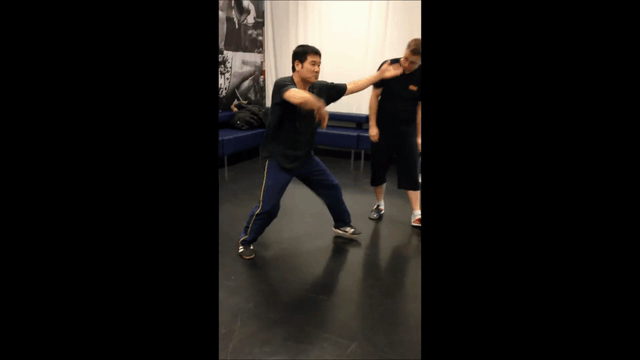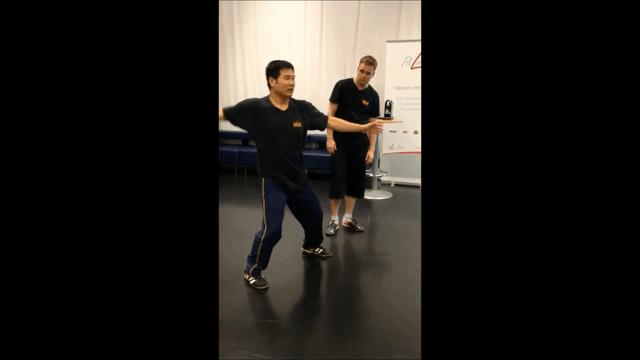Do you agree?
1. Punch with moving the body.

2. Punch without moving the body.




I will say 1 is internal and 2 is external.
Do you agree?

johnwang wrote:When people ask me the difference between internal and external, I will say 1 is internal and 2 is external.
Do you agree?
1. Punch with moving the body.
marvin8 wrote:Yes, Chen's fajin is "sacrificing power by not committing as much kinetic chain motion as" a javelin thrower, baseball pitcher or boxer/MMA. However, the most power may not be Chen's goal. The wider the kinetic chain movement, the more force may be generated. There is a spectrum of kinetic chain movement and power: javelin thrower > boxer > Chen's fajin.
Boxing's straight punch > Chen's reverse/hidden fajin punch ("other than the vague 'qi' explanation"):
In the boxing clips below, Tyson and Hearns both throw jabs that bring their weight to the back foot carrying their head to the left of their opponent. Then, they push off the back foot (lifting heel up), rotate their waist and shoulders first, transfer their weight to the front foot where their head is to the right of their opponent, then finally issue/punch.
There are 3 weight distribution positions: 1) off the line with weight on the back foot, 2) centerline, 3) off the line with weight on the front foot. In the clips below, both Tyson and Hearns make greater use of their lines (e.g., greater weight shifts, rotation and off the line/position for defense) than Chen—generating more power while keeping their central equilibrium.

johnwang wrote:When people ask me the difference between internal and external, I will say 1 is internal and 2 is external.
Do you agree?
1. Punch with moving the body.
2. Punch without moving the body.
1. Punch with moving the body.
2. 1. Punch without moving the body.


Walk the Torque wrote:Move inside or outside?
marvin8 wrote:Excerpt from "A New Paradigm in Biomechanics: Fascia, Rotation, and Waves," https://www.just-fly-sports.com/biomech ... ion-waves/:Kevin Foster on July 16, 2018 wrote:Neuro-fascial System
The role of fascia in movement has always been a highly debated and somewhat mysterious topic. Highly elastic in nature, and heavily integrated into the neural network of movement, the neuro-fascial system helps explain the importance of a proximal to distal activation sequence.
As our connecting piece of anatomy to the ground, our feet play a massive role in the facilitation of tension through the neuro-fascial system. Our feet have an astonishing number of afferent neural connections that reflexively communicate tension up these neuro-fascial pathways. How our foot strikes the ground therefore plays an important role in where the tension goes.
Rotational Dynamics in Arthro- and Osteo-kinematics
At the level of the joint there is no such thing as linear movement. There are muscles that pull on tendons that pull bones in arcs and circles. By understanding this, we can see linear motion as a finely choreographed sequence of arcs and rotation, that when pieced together create a straight line.
When looking at movements pieced together in this way, we can see the importance of rotation in the creation and transfer of energy in movement. An important concept from Adarian Barr’s work is the role of end range of rotational motion in timing and energy transfer.
As an example of this concept, look at how energy gets transferred through the kinetic chain in a baseball or javelin throw: Energy of internal rotation of the right side of the pelvis gets stopped and absorbed by the stiffness of the left hip (think about a bicyclist crashing into a curb and flying over the handle bars to help visualize this example). The linear and angular momentum of the body causes this energy to get transferred up the spine, where end range of thoracic extension and rotation acts as another “curb” that transfers energy to the scapula.
https://www.youtube.com/watch?v=wEFfsg8MYbY
Jan Zelezny is the epitome of these motions in action
The end range of scapular retraction and posterior tilt acts as another “curb” that forces gleno-humeral external rotation. When the shoulder hits its end range of external rotation, it acts as a “curb” for the transfer of energy into elbow extension, whose end range acts as a “curb” for gleno-humeral internal rotation and forearm pronation.
There are three key takeaways from this example.
First, as noted above, is that individually these motions all occur in arcs and rotations, but synergistically pull the baseball or javelin in a perfectly straight line.
Second, is that at these “curbs,” the mass of each lever gets progressively smaller, so the conservation of angular momentum plays a massive role in accelerating limbs to high speeds.
The third is that the end ranges of these joints act as a built in “timer” for movement. If you have adequate mobility, and the ability to stay relaxed, each joint will perform its actions when the force gets there.
Timing, Waves, and Elastic Energy
Muscles, tendons, and fascia are all intrinsically elastic. The stretching and contracting of these elastic tissues can be looked at as waves of tension. Remember back in physics class, how all waves followed a sine function when analyzed on a graph? The same concept can apply to stretching and contracting muscles/tendons/fascia.
Building on this concept, when two waves “collide” they can either be constructive or destructive. That is, they can either add together, or cancel each other out.
Whether they add together or cancel out is a function of timing.
https://www.instagram.com/p/BcPdMwHjGxJ/?utm_source=ig_embed


Return to Xingyiquan - Baguazhang - Taijiquan
Users browsing this forum: No registered users and 95 guests